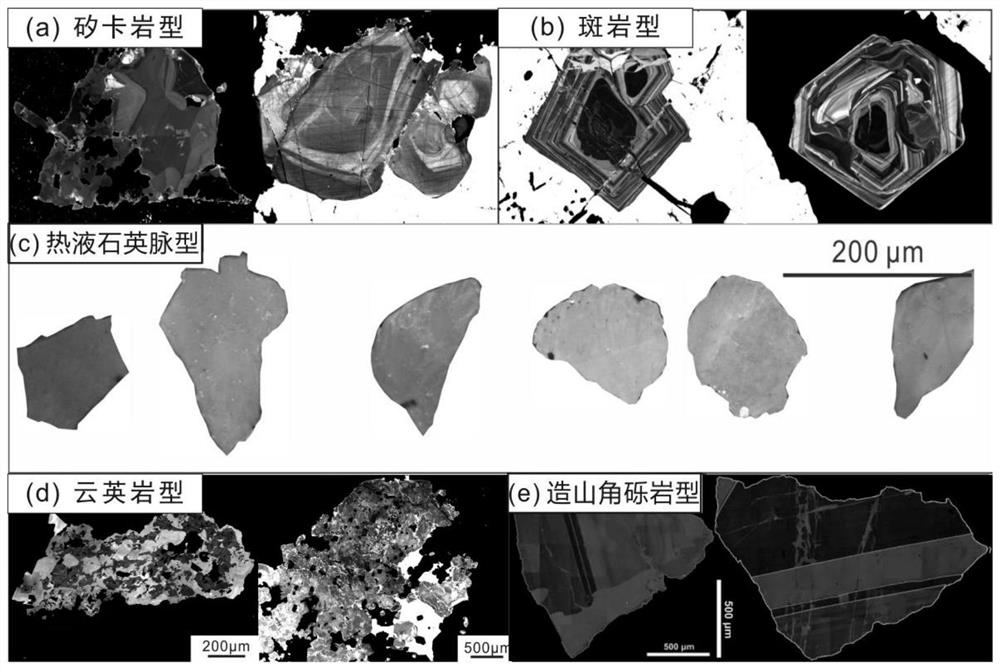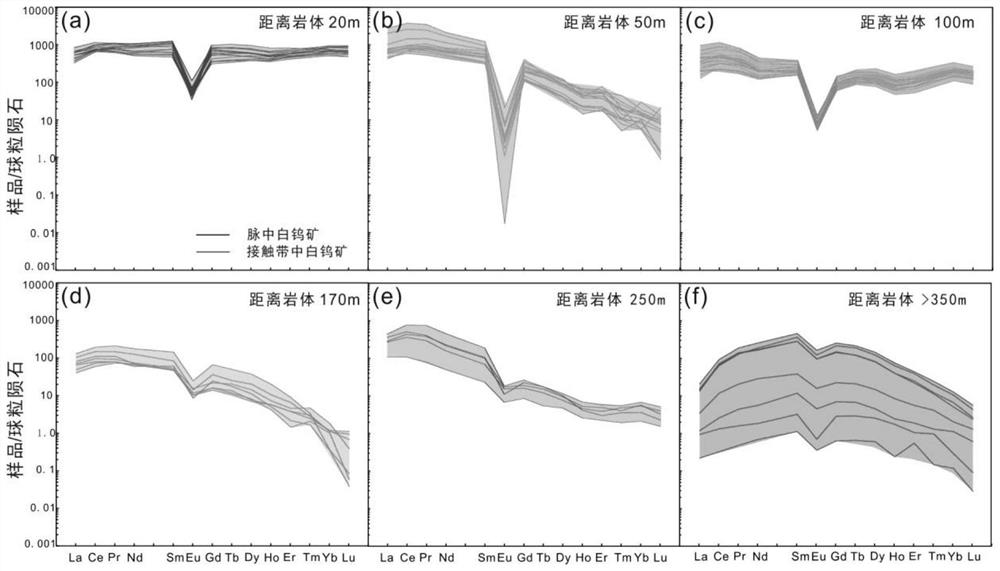Scheelite mineralogy prospecting method for accurately judging tungsten polymetallic deposit type and denudation depth
A scheelite and polymetallic technology, applied in the field of ore prospecting and exploration, can solve problems such as inability to obtain deposit information, labor and capital consumption, multi-solution surface pollution interference, etc., to eliminate external interference and multi-solution, eliminate interference effect
- Summary
- Abstract
- Description
- Claims
- Application Information
AI Technical Summary
Problems solved by technology
Method used
Image
Examples
Embodiment 1
[0027] S2: The scheelite was embedded in epoxy resin, polished, and polished using a Tescan MIRA 3 field emission scanning electron microscope (SEM) (equipped with a Delmic sparc cathodofluorescence probe. The operating voltage was 0.5-30 kV, and the filament emission current was 72 μA. Spectral analysis test conditions Accelerating voltage is generally 20-30KV, working distance 9.5-10.5mm) to take pictures to obtain CL images of scheelite (such as figure 1 ). The content of trace elements in different regions of the same particle leads to significant differences in its cathodoluminescence characteristics, and the microstructure revealed by cathodoluminescence (CL) can reveal the growth history of minerals and reflect the crystallization environment ( figure 1 ). Summarizing previous studies, CL images of scheelite in different types of tungsten deposits show different characteristics: CL images of scheelite in skarn-type deposits generally develop obvious fan-shaped partitio...
Embodiment 2
[0029]Step S2 is the same as in Example 2, and S3 is specifically described here: According to the CL image characteristics of scheelite, use Geolaspro 193nm laser ablation system for different CL partitions to measure the content of trace elements in different partitions of scheelite particles (laser beam spot and frequency 35 μm and 10 Hz respectively), the offline processing of the analytical data (including the selection of samples and blank signals, instrument sensitivity drift correction and element content calculation) was performed by the software ICPMSDataCal software to obtain the content of various trace elements in different areas of the scheelite. The rare earth distribution pattern of scheelite has important reference significance for judging the type and characteristics of scheelite. At different distances from the rock mass, the rare earth distribution pattern of scheelite has obvious differences, (such as figure 2 ), through the difference of rare earth distri...
Embodiment 3
[0031] Steps S2-S3 are the same as those of Embodiment 2, and S4 is specifically described here:
[0032] S4: O isotope analysis of scheelite using solution method oxygen isotope analysis on Thermo-FinniganDeltaPlus XP Isotope-Ratio Mass Spectrometer (IRMS) instrument, H in inclusions 2 O and BrF 5 React at a constant temperature of 300 °C for 20 min to generate O purified by freezing 2 . Oxygen reacts with graphite to form CO at 700 °C under Pb catalyst conditions 2 , and the oxygen isotope composition was analyzed by MAT253 gas isotope mass spectrometer. The measurement results are based on SMOW, recorded as δ18OV-SMOW, and the analytical accuracy is better than ±0.2‰. The oxygen isotope reference standard is GBW-04409 and GBW-04410 quartz standard, δ18OH 2 The O values were 11.11±0.06‰ and -1.75±0.08‰, respectively. isolated pure O 2 , and by O 2 Reacts with carbon rods to produce CO 2 gas. CO collected 2 Gas was tested by mass spectrometry. The accuracy of a ...
PUM
 Login to View More
Login to View More Abstract
Description
Claims
Application Information
 Login to View More
Login to View More - R&D
- Intellectual Property
- Life Sciences
- Materials
- Tech Scout
- Unparalleled Data Quality
- Higher Quality Content
- 60% Fewer Hallucinations
Browse by: Latest US Patents, China's latest patents, Technical Efficacy Thesaurus, Application Domain, Technology Topic, Popular Technical Reports.
© 2025 PatSnap. All rights reserved.Legal|Privacy policy|Modern Slavery Act Transparency Statement|Sitemap|About US| Contact US: help@patsnap.com



